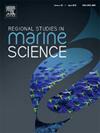The feasibility of estimating biological parameters using electronic length frequency analysis (ELEFAN): The Bohai Sea as a case study
IF 2.1
4区 环境科学与生态学
Q3 ECOLOGY
引用次数: 0
Abstract
Biological parameter estimation is crucial for modeling fish population dynamics to inform fishery management. However, biological data are mostly inadequate for the modeling except for few exploited species. Body length is readily obtainable and can be input to ELEFAN (electronic length frequency analysis), offering simplicity and accessibility, albeit with limitations. In order to test the feasibility of estimating biological parameters using ELEFAN, we used fishery independent surveys of stocks in the Bohai Sea (BS), where performance evaluation and revised fisheries management strategies are needed, as a case study. We analyzed the variation in biological characteristics of ten species encompassing teleosts, crustaceans and cephalopod prevalent in the BS, over four consecutive seasons (from December, 2016 to November 2017), selected for their representativeness of biodiversity, varying life history traits, and significance in fisheries. ELEFAN outputs showed that seven of ten species had high (> 0.70) exploitation rates (E), but some values are hard to explain in ecological and economic sense. Long-lived species comprised more cohorts with lower instantaneous mortality rates (Z, F, and M) than short-lived species. High instantaneous mortality rates from ELEFAN likely stem from fishing gear selectivity, seasonal migration, and errors in asymptotic length due to truncated length data. Monthly mean body size distribution variation for each species may reflect spawning behavior and summer fishing moratorium impact. However, feeding ecology and breeding strategies should be enhanced due to current insufficient data collection. We clarified the current biological status and ecological importance of these species, provided population dynamic parameters for fisheries management and baseline information for future comparison of long-term biological variation among species. This may serve as guidance for practitioners in other countries deciding upon what kinds of data should be collected for scientific assessments of their fisheries, and caution is needed when using ELEFAN for parameter estimation.
求助全文
约1分钟内获得全文
求助全文
来源期刊

Regional Studies in Marine Science
Agricultural and Biological Sciences-Ecology, Evolution, Behavior and Systematics
CiteScore
3.90
自引率
4.80%
发文量
336
审稿时长
69 days
期刊介绍:
REGIONAL STUDIES IN MARINE SCIENCE will publish scientifically sound papers on regional aspects of maritime and marine resources in estuaries, coastal zones, continental shelf, the seas and oceans.
 求助内容:
求助内容: 应助结果提醒方式:
应助结果提醒方式:


